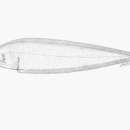Diagnostic Description
provided by Fishbase
Eyed side reddish brown, sometimes with irregular brown-black patches, with a large black blotch on gill cover. Body very elongate, its depth 17 to 22% SL. Eyes with a small interorbital space. Corner of mouth reaching well beyond vertical through posterior margin of lower eye, much nearer to gill opening than to tip of snout. Caudal-fin rays 10. No lateral lines on blind side. Scales comparatively large, ctenoid on eyed side of body, cycloid (smooth) on blind side. Midlateral-line scales 90 to 101. Only 11 or 12 scale rows between lateral lines on eyed side of body (Ref 9895).
Diseases and Parasites
provided by Fishbase
Neoechinorhynchus Disease. Parasitic infestations (protozoa, worms, etc.)
Migration
provided by Fishbase
Amphidromous. Refers to fishes that regularly migrate between freshwater and the sea (in both directions), but not for the purpose of breeding, as in anadromous and catadromous species. Sub-division of diadromous. Migrations should be cyclical and predictable and cover more than 100 km.Characteristic elements in amphidromy are: reproduction in fresh water, passage to sea by newly hatched larvae, a period of feeding and growing at sea usually a few months long, return to fresh water of well-grown juveniles, a further period of feeding and growing in fresh water, followed by reproduction there (Ref. 82692).
Morphology
provided by Fishbase
Dorsal spines (total): 0; Dorsal soft rays (total): 126 - 138; Analspines: 0; Analsoft rays: 97 - 114
Biology
provided by Fishbase
Adults live mainly in shallow muddy and sandy bottoms of the continental shelf, sometimes entering estuaries and tidal rivers (Ref. 1479, 48637). Usually deeply buried in the substrate during the day, but out and hunting at night (Ref. 48637). They feed mainly on benthic invertebrates. Marketed mostly fresh and frozen; also dried-salted (Ref. 9895).
Comprehensive Description
provided by Smithsonian Contributions to Zoology
Cynoglossus lingua Hamilton-Buchanan
“Jerree Potoo.”—Russell, 1803:57, pl. 73.
Cynoglossus lingua Hamilton-Buchanan, 1822:32, 365 [type-locality: Gangetic estuaries].—Vinciguerra. 1889:190.—Günther, 1862:501.—Day, 1877:433, pl. 96: fig. 1; 1889:454, fig. 163.—Norman, 1928:200, fig. 16.—Weber and de Beaufort, 1929:203.—Smith, 1933:83.—Suvatti, 1936:97; 1950:327. —Munro, 1955:264.—Fowler, 1956:186.—Scott, 1959:42.—Kuronuma, 1961:32.—Pradhan, 1964:458 [Bombay coast].—Punpoka, 1964:62, fig. 20.
Plagusia lingua.—Cantor, 1850:1215.—Jerdon, 1853:148.
Arelia lingua.—Kaup, 1858:107.
Pleuronectes potous Cuvier, 1836:307.
Plagusia potous.—Bleeker, 1852:23.—Jerdon, 1853:148.
Arelia potous.—Bleeker, 1859:185.
Cynoglossus potous.—Bleeker, 1875:33. pl. 241: fig. 4.
Plagusia macrorhynchos Bleeker, 1851a:413 [type-locality: Tjilankahan]; 1852:22.
Arelia macrorhynchos.—Kner, 1867:295.—Bleeker, 1875:3, pl. 242: fig. 2.—Weber and de Beaufort, 1929:208.
Cynoglossus acinaces Jenkins, 1910b:130 [type-locality: Khulna, E. Bengal].
DESCRIPTION.—Based on 18 specimens, 214.0–345.0 mm SL.
Depth of body 17.24–21.71 (M = 18.94), length of head 21.17–25.75 (M = 22.95) percent of standard length. Diameter of eye 5.26–8.51 (M = 6.51), interorbital width 1.75–6.40 (M = 3.28) percent in length of head. Anterior nostril of eyed side tubular, in front of lower eye, on upper lip, posterior nostril simple, in anterior half of interorbital space. Snout pointed, 37.04–45.00 (M = 41.21) percent of length of head, rostral hook rather short, extending just below the anterior nostril. Maxillary extending well beyond fixed eye; angle of mouth extending to just beyond vertical from posterior border of fixed eye, nearer to branchial opening than to tip of snout; tip of snout to angle of mouth 50.00–58.33 (M = 53.81), angle of mouth to branchial opening 40.47–49.09 (M = 45.57) percent of length of head.
Scales: Ctenoid on ocular side with cycloid scales on head and on the lateral lines; cycloid on blind side.
Lateral-Line System: Two lateral lines on ocular side, midlateral line with 90–101 scales, 11–12 scales between them. No lateral line on blind side. The midlateral line on the ocular side, instead of opening through simple pores on every scale, opens by means of ducts, one on either side into the adjoining scale (Figure 2).
Interlinear scale rows 11 12
Frequencies 5 16
Fins: Dorsal with 126–138 (M = 132) rays, anal with 97–114 (M = 101) rays, caudal 10 in 17 specimens (radiographs).
Vertebrae: 57–66, comprising 9 abdominal and 48–57 caudal elements in 17 specimens (radiographs).
Coloration: Upper side uniformly brown with or without darker patches, lower lighter in preserved specimens.
Size: Largest specimen examined, 378 (355 + 23) mm, is from Indonesia.
DISTRIBUTION.—From Malay Archipelago including Thailand and Vietnam to seas and estuaries of India and Pakistan.
DIAGNOSIS AND
- bibliographic citation
- Menon, A. G. K. 1977. "A systematic monograph of the tongue soles of the genus Cynoglossus Hamilton-Buchanan (Pisces, Cynoglossidae)." Smithsonian Contributions to Zoology. 1-129. https://doi.org/10.5479/si.00810282.238
Cynoglossus lingua: Brief Summary
provided by wikipedia EN
Cynoglossus lingua, commonly known as the long tongue sole or textile tongue sole is a species of fish found along the coast of the Philippines, Thailand and the Malay peninsula, Myanmar, the Bay of Bengal and as far west as the Red Sea.
- license
- cc-by-sa-3.0
- copyright
- Wikipedia authors and editors

